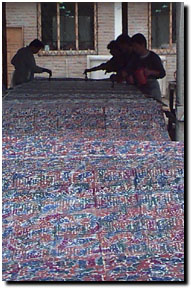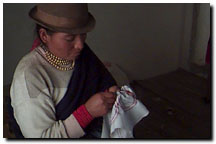|
||||||
|
||||||
 Quilts assembled by village women are then finished at the factory. Profits go to the women's agricultural collective. (Photograph by Denise Rocco) |

|
|
Using remnants from the nearby Herrera-Miller/Winter Sun fabric factory, patches are distributed to the women, who stitch them together during their breaks from the field. Profits from the assembled patchwork quilts go to the agricultural cooperatives, with the hope that the pieces of fabric will eventually enable the women to fully own a piece of land. Currently, Patchwork Project volunteers in California are working to create a website, where the quilts will be more readily available to a worldwide market.
|
 The piecework nature of the project ensures that the women can carry on their lives at home and in the fields. (Photograph by Denise Rocco) |

mailto:hemitx1@herrmiller.com.ec

|
Please direct all inquiries to: cyber24rs@aol.com
©1996, 24 Hours in Cyberspace Inc., All Rights Reserved.



 igh in the Ecuadorean hills and far from any urban center, Cayambe village women struggle to raise crops on lands recently purchased from hacienda owners. The women, who belong to an agricultural cooperative, often rise before dawn and work until sunset. Yet, despite the long days and hard work, their debt level remains prohibitively high. The question of how to help the women plagued Linda D'Amico, an anthropologist who had been based in the region while working for Unesco, a private voluntary organization. D'Amico took the issue to the South American Explorer's Club website, and her online efforts led to an introduction to the owner of a nearby textile company. Through the discussions that ensued, the Patchwork Project was born.
igh in the Ecuadorean hills and far from any urban center, Cayambe village women struggle to raise crops on lands recently purchased from hacienda owners. The women, who belong to an agricultural cooperative, often rise before dawn and work until sunset. Yet, despite the long days and hard work, their debt level remains prohibitively high. The question of how to help the women plagued Linda D'Amico, an anthropologist who had been based in the region while working for Unesco, a private voluntary organization. D'Amico took the issue to the South American Explorer's Club website, and her online efforts led to an introduction to the owner of a nearby textile company. Through the discussions that ensued, the Patchwork Project was born.